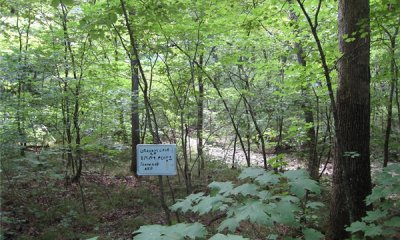
Loamy/Gravelly Upland Drainageway Forest
Scenario model
Current ecosystem state
Select a state
Management practices/drivers
Select a transition or restoration pathway
- Transition T1A More details
- Transition T1B More details
- Transition T1C More details
- Transition T1D More details
- Transition T2A More details
- Restoration pathway R1A More details
- Transition T3A More details
- Restoration pathway T4A More details
- Restoration pathway T5B More details
- Transition T5A More details
-
No transition or restoration pathway between the selected states has been described
Target ecosystem state
Select a state
Description
The reference state was dominated by northern red oak and sugar maple including a wide variety of other deciduous hardwood tree species. Maximum tree age was likely 150 to 300 years. Periodic disturbances from fire, wind or occurred along with infrequent flooding. Long disturbance-free periods allowed an increase in more shade tolerant species such as bitternut hickory and sugar maple. Two community phases are recognized in this state, with shifts between phases based on disturbance frequency.
Submodel
Description
Occasionally, on wider drainageways, this ecological site is cleared and converted to cropland with a narrow strip of woodland retained along the stream edge. Major crops include corn, soybeans and wheat.
Submodel
Description
Managed forests can resemble the reference state but are denser. The biggest differences are tree age, most being only 50 to 90 years old, and canopy closure. Composition is also likely altered from the reference state depending on tree selection during harvest. In addition, without a regular 15 to 20 year harvest re-entry into these stands, they will slowly increase in more shade tolerant species such as bitternut hickory and sugar maple and northern red oak will become less dominant.
Submodel
Description
Conversion of forests to planted, non-native cool season grassland species such as tall fescue and red clover has been common in this region. High grain commodity prices will encourage transition to State 2 (Cropland).
Submodel
Description
Forested sites subjected to repeated, high-graded timber harvests and uncontrolled domestic grazing transition to this state. This state exhibits an over-abundance of hickory and other less desirable tree species, and weedy understory species such as buckbrush, gooseberry, poison ivy and Virginia creeper. The vegetation offers little nutritional value for cattle, and excessive stocking damages tree boles, degrades understory species composition and results in soil compaction and accelerated erosion and runoff.
Submodel
Mechanism
This transition is the result of clearing, tillage and conservation cropping system.
Mechanism
This transition is the result of timber harvesting and forest stand improvement.
Mechanism
This transition is the result of clearing, grassland planting and grassland management.
Mechanism
Poorly planned harvests (high-grading) and uncontrolled grazing will result this transition.
Mechanism
This transition is the result of grassland planting and grassland management.
Mechanism
This restoration pathway is the result of extended rotations and forest stand improvement.
Mechanism
This transition is the result of clearing, tillage and conservation cropping system.
Mechanism
This transition is the result of tillage and conservation cropping system.
Mechanism
This transition is the result of forest stand improvement, tree planting and livestock exclusion.
Model keys
Briefcase
Add ecological sites and Major Land Resource Areas to your briefcase by clicking on the briefcase (![]() ) icon wherever it occurs. Drag and drop items to reorder. Cookies are used to store briefcase items between browsing sessions. Because of this, the number of items that can be added to your briefcase is limited, and briefcase items added on one device and browser cannot be accessed from another device or browser. Users who do not wish to place cookies on their devices should not use the briefcase tool. Briefcase cookies serve no other purpose than described here and are deleted whenever browsing history is cleared.
) icon wherever it occurs. Drag and drop items to reorder. Cookies are used to store briefcase items between browsing sessions. Because of this, the number of items that can be added to your briefcase is limited, and briefcase items added on one device and browser cannot be accessed from another device or browser. Users who do not wish to place cookies on their devices should not use the briefcase tool. Briefcase cookies serve no other purpose than described here and are deleted whenever browsing history is cleared.
Ecological sites
Major Land Resource Areas
The Ecosystem Dynamics Interpretive Tool is an information system framework developed by the USDA-ARS Jornada Experimental Range, USDA Natural Resources Conservation Service, and New Mexico State University.
